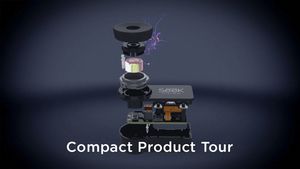



Turn your Smartphone into a Thermal Imager
Thermal imaging provides useful insight into the detection of energy loss in homes, commercial buildings, and industrial facilities. Inspection with thermal imaging detects energy loss caused by air leaks, missing or damaged insulation, inefficient HVAC systems, and poor construction.
Finding and assessing these problems requires a thermal imager to identify hot and cold spots. Seek Thermal Compact thermal imaging cameras enable contractors toconduct building and home inspections quickly and accurately, without the need to crawl through attics and crawlspaces or punch holes in walls to find air leaks, thermal bypasses, and insulation gaps.
Quick to connect and detect, the smartphone attachment is designed to work with both iPhone and Android top models. This device is portable and easy to pack away for any occasion. It combines powerful thermal insight with a 206x156 sensor, a 36-degree wide field of view, and runs off the low energy from your smartphone. Your smartphone display makes this as visual and large as your phone or tablet. Seek Compact uses advanced infrared technology to let you see thermal images in day or night – and comes with its own waterproof carry case. Its detection distance can shorten into a few inches or as far as 1,000 ft.
The difference between the Compact series and our Reveal series is portability, durability, and size. If you are using this in dirty environments where your smartphone is not ideal, choose the Reveal model that’s best for you. If portable connect & detect is right, Seek Compact is the one.
Seek To Know More

Building Envelopes
The building envelope separates the outside environment from the inside and is a frequent location of energy loss. Find water and air leaks, identify structural damage, unsealed gaps and insulation gaps in:
- Roofs
- Walls
- Areas with building envelope penetrations
- Door and window frames and seals

HVAC Motors and Generators
Malfunctioning and overheating motors and generators contribute to energy waste within HVAC systems.
Thermal imaging detects elevated temperatures, which are indicative of system inefficiencies and impending failure in:
- Electrical connections
- Fan-cooled motors
- Bearings
- Winding insulation

HVAC Systems
HVAC systems can be the biggest energy consumer within a commercial and industrial facility. Preventive maintenance and repair can decrease waste and increase efficiency.
Use thermal imaging to find air and heat leaks, overheated components, misconfigurations, and wear in:
- Compressors
- Coils
- Fans and blowers
- Ductwork and registers
- Electrical connections

Boilers
Boilers are at the core of every steam and hot water heating system, and they are frequently a point of energy inefficiency. Thermal imaging can detect error conditions in:
- Refractory and insulation
- Fan motors
- Pumps Valves, Electrical connections

Steam-Heating Systems
Many industrial and commercial facilities still rely on steam for central heating. Thermal imaging can be used to find temperature differentials that show improper operation, leaks, and blockages that affect the efficiency of:
- Steam traps
- Steam lines and valves
- Condensers
- Radiator coils
Electrical Systems
As electrical components degrade, resistance increases and causes energy loss in the form of heat that can be measured using thermal imaging.
Use thermal imaging to find imbalance, impending failure, and loose or corroded connections in:
- Transformers
- Distribution panels
- Lighting circuit controls








